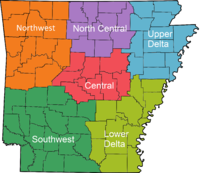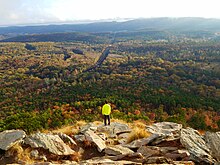
A | B | C | D | E | F | G | H | CH | I | J | K | L | M | N | O | P | Q | R | S | T | U | V | W | X | Y | Z | 0 | 1 | 2 | 3 | 4 | 5 | 6 | 7 | 8 | 9
Central Arkansas | |
|---|---|
| Little Rock-North Little Rock-Conway, AR Metropolitan Statistical Area | |
From top to bottom: Little Rock, North Little Rock, Conway | |
 Components of the Little Rock– North Little Rock, AR CSA Little Rock–North Little Rock–Conway, AR
Pine Bluff, AR MSA
Searcy, AR μSA | |
| Coordinates: 34°44′10″N 92°19′52″W / 34.73611°N 92.33111°W | |
| Country | |
| State | |
| Principal cities | Little Rock North Little Rock Conway |
| Area | |
| • Urban | 669 km2 (258.3 sq mi) |
| • MSA | 10,580.6 km2 (4,085.18 sq mi) |
| • CSA | 18,519.2 km2 (7,150.31 sq mi) |
| Population (2022) | |
| • Urban | 461,864 (US: 89th) |
| • MSA | 748,031 (US: 81st) |
| • CSA | 912,604 (US: 62nd) |
| GDP | |
| • MSA | $47.322 billion (2022) |
| Time zone | UTC-6 (CST) |
| • Summer (DST) | UTC-5 (CDT) |
| Area code | 501 & 870 |
| Part of a series on |
| Regions of Arkansas |
|---|
 |
Central Arkansas, also known as the Little Rock metro, designated by the United States Office of Management and Budget as the Little Rock-North Little Rock-Conway Metropolitan Statistical Area, is the most populous metro area in the U.S. state of Arkansas. With an estimated 2020 population of 748,031, it is the most populated area in Arkansas. Located at the convergence of Arkansas's other geographic regions, the region's central location make Central Arkansas an important population, economic, education, and political center in Arkansas and the South. Little Rock is the state's capital and largest city, and the city is also home to two Fortune 500 companies, Arkansas Children's Hospital, and University of Arkansas for Medical Sciences (UAMS).
History
The site known as "little rock" along the Arkansas River was found by explorer Bernard de la Harpe in 1722.[2] The territorial capitol had been located at Arkansas Post in Southeast Arkansas since 1819, but the site had proven unsuitable as a settlement due to frequent flooding of the Arkansas River. Over the years, the "little rock" was known as a waypoint along the river, but remained unsettled. A land speculator from St. Louis, Missouri who had acquired many acres around the "little rock" began pressuring the Arkansas territorial legislature in February 1820 to move the capital to the site, but the representatives could not decide between Little Rock or Cadron (now Conway), which was the preferred site of Territorial Governor James Miller. The issue was tabled until October 1820, by which time most of the legislators and other influential men had purchased lots around Little Rock.[3] The legislature moved the capital to Little Rock, where it has remained ever since.
Geography
Central Arkansas is located in the Southern United States (commonly known as the South in the US), and within a subregion commonly known as the Deep South, although it is influenced by Upper South culture. The South is a distinct cultural region reliant upon a plantation economy in the 18th and 19th century, until the secession of the Confederate States of America and the Civil War.
The region is the point of convergence for five other Arkansas regions: the Ozarks to the north, the Arkansas River Valley & the Ouachita Mountains to the west, the Arkansas Delta to the east, and Piney Woods to the southwest.

The Arkansas River crosses the region, and serves as the dividing line between Little Rock and North Little Rock. The Arkansas is an important geographic feature in Central Arkansas, requiring long bridge spans but allowing barge traffic to the Port of Little Rock and points upriver.
Demographics
| Census | Pop. | Note | %± |
|---|---|---|---|
| 1840 | 7,411 | — | |
| 1850 | 10,538 | 42.2% | |
| 1860 | 20,804 | 97.4% | |
| 1870 | 42,605 | 104.8% | |
| 1880 | 76,558 | 79.7% | |
| 1890 | 109,569 | 43.1% | |
| 1900 | 134,590 | 22.8% | |
| 1910 | 173,926 | 29.2% | |
| 1920 | 207,941 | 19.6% | |
| 1930 | 233,056 | 12.1% | |
| 1940 | 249,799 | 7.2% | |
| 1950 | 288,070 | 15.3% | |
| 1960 | 334,011 | 15.9% | |
| 1970 | 396,462 | 18.7% | |
| 1980 | 494,758 | 24.8% | |
| 1990 | 535,034 | 8.1% | |
| 2000 | 610,518 | 14.1% | |
| 2010 | 699,757 | 14.6% | |
| 2020 | 748,031 | 6.9% | |
| U.S. Decennial Census[4] 1790–1960[5] 1900–1990[6] 1990–2000[7] | |||
Central Arkansas includes both the Little Rock-North Little Rock-Conway MSA, though the broader Little Rock CSA is also considered Central Arkansas. The MSA is defined by the United States Office of Management and Budget as Faulkner, Grant, Lonoke, Perry, Pulaski and Saline counties. The CSA definition adds the Pine Bluff metropolitan area adding Cleveland, Jefferson, and Lincoln counties, and the Searcy Micropolitan Area, which adds White County.
It is the core of the broader Little Rock-North Little Rock Combined Statistical Area (CSA). Its economic, cultural, and demographic center is Little Rock, Arkansas's capital and largest city. The Little Rock Combined Statistical area spans ten counties and had an estimated population of 905,847 in 2016.[8]
Prior to 2002, the area consisted of four core counties: Pulaski, Faulkner, Saline and Lonoke. The area was later expanded to include adjoining Perry County to the west, and Grant County to the south. The city of Conway was designated as a third principal city for the MSA by 2007.
| County Ref. |
Population | Land mi2 |
Land km2 |
Pop. /mi2 |
Pop. /km2 |
|---|---|---|---|---|---|
| Pulaski County[9] | 393,250 | 759.76 | 1,967.77 | 503.8 | 194.52 |
| Faulkner County[10] | 122,227 | 647.88 | 1,678.00 | 174.8 | 67.49 |
| Saline County[11] | 118,703 | 723.60 | 1,874.12 | 148.0 | 57.14 |
| Lonoke County[12] | 72,228 | 770.73 | 1,996.18 | 88.7 | 34.25 |
| Grant County[13] | 18,082 | 631.81 | 1,636.38 | 28.3 | 10.93 |
| Perry County[14] | 10,132 | 551.40 | 1,428.12 | 18.9 | 7.30 |
| Central Arkansas | 734,622 | 4,085.18 | 10,580.57 | 179.8 | 69.42 |
| Jefferson County[15] | 70,016 | 870.75 | 2,255.23 | 88.9 | 34.32 |
| Lincoln County[15] | 13,705 | 561.52 | 1,454.33 | 25.2 | 9.73 |
| Cleveland County[15] | 8,241 | 597.78 | 1,548.24 | 14.5 | 5.60 |
| Pine Bluff MSA | 91,962 | 2,030.05 | 5,257.81 | 45.3 | 17.49 |
| Searcy μSA[16] | 79,263 | 1,035.08 | 2,680.84 | 74.5 | 28.76 |
| CSA | 905,847 | 7,150.31 | 18,519.22 | 126.7 | 48.92 |
| Arkansas | 2,988,248 | 52,035.48 | 134,771.27 | 56.0 | 21.62 |
2000 Census
MSA
As of the census[17] of 2000, there were 610,518 people, 241,094 households, and 165,405 families residing within the MSA. The racial makeup of the MSA was 75.40% White, 21.02% African American, 0.44% Native American, 0.96% Asian, 0.04% Pacific Islander, 0.87% from other races, and 1.27% from two or more races. Hispanic or Latino of any race were 2.07% of the population.
The median income for a household in the MSA was $37,912, and the median income for a family was $44,572. Males had a median income of $31,670 versus $23,354 for females. The per capita income for the MSA was $18,305.
CSA
As of the census[17] of 2000, there were 785,024 people, 304,335 households, and 210,966 families residing within the CSA. The racial makeup of the CSA was 73.97% White, 22.73% African American, 0.42% Native American, 0.85% Asian, 0.04% Pacific Islander, 0.80% from other races, and 1.20% from two or more races. Hispanic or Latino of any race were 1.93% of the population.
The median income for a household in the CSA was $35,301, and the median income for a family was $41,804. Males had a median income of $31,192 versus $22,347 for females. The per capita income for the CSA was $16,898.
Communities
Communities are categorized based on their populations in the 2000 U.S. Census.
Places with more than 100,000 inhabitants
- Little Rock (principal city) (202,591)
Places with 50,000 to 100,000 inhabitants
- North Little Rock (principal city) (64,591)
- Conway (principal city) (64,134)
Places with 10,000 to 50,000 inhabitants
- Pine Bluff (41,253)
- Benton (35,014)
- Sherwood (32,731)
- Jacksonville (28,364)
- Cabot (23,776)
- Searcy (23,098)
- Maumelle (19,251)
- Bryant (16,688)
- Hot Springs Village (partial) (15,861)
Places with 1,000 to 10,000 inhabitants
|
|
Places with 500 to 1,000 inhabitants
|
Places with fewer than 500 inhabitants
|
Population trends
| Year | Metropolitan Statistical Area |
Combined Statistical Area |
|---|---|---|
| 2020 Census | 748,031 | 912,604 |
| 2014 est. | 729,135 | 902,443 |
| 2005 est. | 645,706 | 820,846 |
| 2000 Census | 610,518 | 785,024 |
Economy
The Little Rock Regional Chamber of Commerce, the oldest association in Arkansas, has produced the following list of largest employers in Central Arkansas.
| Employer | Number of employees |
|---|---|
| State of Arkansas | 32,200 |
| Local government | 28,800 |
| Federal government | 9,200 |
| University of Arkansas for Medical Sciences | 8,500 |
| Baptist Health | 7,000 |
| Little Rock Air Force Base | 4,500 |
| Acxiom | 4,380 |
| Little Rock School District | 3,500 |
| Central Arkansas Veterans Healthcare System | 3,500 |
| Entergy Arkansas | 2,740 |
| Pulaski County Special School District | 2,700 |
| AT&T | 2,600 |
| CHI St. Vincent Health System | 2,600 |
| Arkansas Children’s Hospital | 2,470 |
| Dillard's | 2,400 |
| Verizon Wireless | 2,000 |
| Union Pacific Railroad | 2,000 |
| Arkansas Blue Cross Blue Shield | 1,800 |
| Dassault Falcon Jet Corp. | 2,000 |
| CenterPoint Energy | 1,800 |
Source: Little Rock Regional Chamber of Commerce





